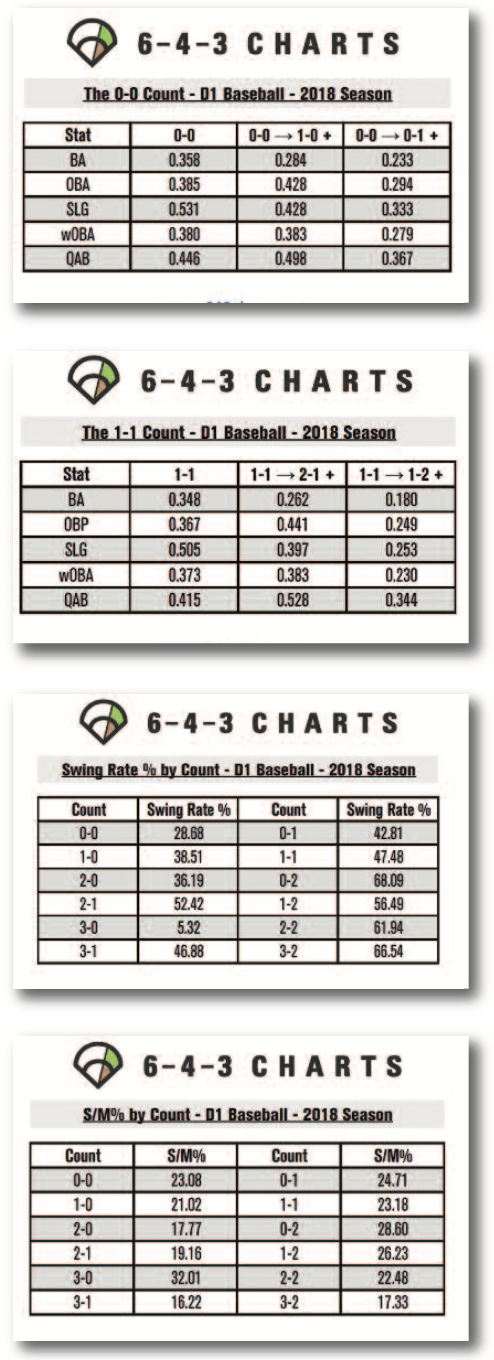
It is well documented that throwing first pitch strikes at the MLB level gives a great advantage to the pitcher. Jerry Weinstein has broken down that advantage on his website (
https://www.weinsteinbaseball.com/strikes) for the MLB level, and has pointed out that the “statistical validation for first pitch strikes is irrefutable.”
Weinstein found that 92.7% of first pitch strikes led to an out or strike one, meaning that a meager 8 percent of first pitch strikes result in hits. 69% of strikeouts start with a first pitch strike, and 70% of walks start with first pitch balls in Major League Baseball.
In his findings, Weinstein observed that MLB pitchers throw approximately 57% first pitch strikes, but they should be capable of a much better figure. In 3-0 counts, MLB hurlers pour in strikes at an 80% rate. Weinstein concludes that if “if a big league pitching staff improved their first pitch strike percentage from 57% to 80%, it would translate into one 100 fewer runs allowed over the course of a season. That translates into 10 more big league wins.”
Taking things a step further, the ability to throw two strikes within the first three pitches of an AB is also a valuable asset. According to Weinstein, “if you throw a first pitch strike, you have an 80% chance of throwing two of the first three pitches for strikes & if you throw a first pitch ball, your percentages fall to 30%. Once you throw a first pitch strike, your slash line falls to .239/.283/.372. The expected runs scored after a first pitch ball jumps to .069 runs vs .029 runs if you throw a first pitch strike.”
Thanks to the technology provided by 6-4-3 Charts, we are now able to compute the same data at the college level.
6-4-3 Charts CEO Derek Weldon helped us pull together the following data, which he has tweeted out in the past (
@643Charts):
0-0 stats and stats pertaining to all PA’s that travel through the 1-0 count and 0-1 count respectively, regardless of what count the PA ends in
- Same tracking through the 1-1 count
- S/M % by count for all of DI baseball
- Swing Rate by count for all of DI baseball
Rick Ahlf, Chief Technology Officer for 6-4-3 Charts, also helped Inside Pitch with the following data for Division I baseball:
- First pitch strike leading to out or strike one: 92.8 % (compared to 92.7% at MLB level)
- Percentage of strikeouts starting with first pitch strikes: 66.8 % (68% in MLB)
- Percentage of walks starting with first pitch balls: 74.3 % (70% in MLB)
- Overall first pitch strike percentage: 58.4 % (57% in MLB)
As evidenced by the aforementioned metrics, college baseball’s highest level is on par with the MLB level in terms of first pitch strikes leading to an out or strike one, percentage of strikeouts starting with first pitch strikes, percentage of walks starting with first pitch balls, and overall first pitch strike percentage. Only 3-0 count strike percentage is vastly different; in Division I baseball, that percentage is only 58.3%, compared to 80% at the MLB level.
“It’s eerie how close many of the statistics fall in contrast to the Majors, with the exception of the 3-0 strike percentage being significantly lower (which is rather expected),” Ahlf observes. “Fun fact, No. 1 overall draft pick Casey Mize does indeed have an 80% 3-0 strike percentage after running the numbers.”
The correlation between first pitch strikes and any pitcher’s desired outcome- an out- is so similar it’s scary when comparing Division I pitchers to their MLB counterparts. What the contrast in 3-0 count strikes (58.3% in college versus 80% in MLB) suggests is—as it stands— college pitchers are achieving a high rate of success when it comes to first pitch strikes, but executing strikes in a 3-0 count—arguably the most optimal count to throw a strike— at a lower rate than MLB pitchers.
Hopefully this information will help your team set reasonable goals for these statistical categories as the season continues. Good luck and keep pounding the zone!